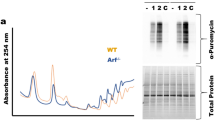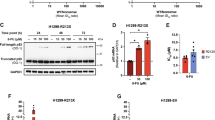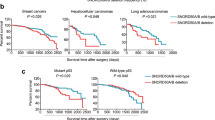Abstract
Tumor-suppressor protein p53, the ‘guardian of the genome’, is critical in maintaining cellular homeostasis and genomic stability. Earlier, we have reported the discovery of internal ribosome entry sites (IRESs) within the p53 mRNA that regulate the translation of the full length and its N-terminal-truncated isoform, ΔN-p53. Polypyrimidine tract-binding protein (PTB) is an IRES trans-acting factor that positively regulates the IRES activities of both p53 isoforms by relocating from nucleus to the cytoplasm during stress conditions. Here we have demonstrated the putative contact points of PTB on the p53 IRES RNA. Studies on mutations that occur naturally in the 5′ untranslated region (5′ UTR) in p53 mRNA were lacking. We have investigated a naturally occurring C-to-T single-nucleotide polymorphism (SNP) first reported in human melanoma tumors. This SNP is at position 119 in the 5′ UTR of p53 mRNA and we demonstrate that it has consequences on the translational control of p53. Introduction of this SNP has led to decrease in cap-independent translation from p53 5′ UTR in bicistronic reporter assay. Further, the effects of this SNP on cap-independent translation have been studied in the context of p53 cDNA as well. Interestingly, the 5′ UTR with this SNP has shown reduced binding to PTB that can be corroborated to its weaker IRES activity. Previously, it has been shown that G2–M checkpoint, DNA-damaging stress and oncogenic insult favor IRES-mediated translation. Under similar conditions, we demonstrate that this SNP interferes with the enhancement of the IRES activity of the 5′ UTR. Taken together, the results demonstrate for the first time that SNP in the 5′ UTR of the p53 mRNA might have a role in translational control of this critical tumor-suppressor gene.
This is a preview of subscription content, access via your institution
Access options
Subscribe to this journal
Receive 50 print issues and online access
$259.00 per year
only $5.18 per issue
Buy this article
- Purchase on Springer Link
- Instant access to full article PDF
Prices may be subject to local taxes which are calculated during checkout








Similar content being viewed by others
Accession codes
References
Levine AJ, Oren M . The first 30 years of p53: growing ever more complex. Nat Rev Cancer 2009; 9: 749–758.
Vousden KH, Prives C . Blinded by the light: the growing complexity of p53. Cell 2009; 137: 413–431.
Hollstein M, Sidransky D, Vogelstein B, Harris CC . p53 mutations in human cancers. Science 1991; 253: 49–53.
Yang DQ, Halaby MJ, Zhang Y . The identification of an internal ribosomal entry site in the 5′-untranslated region of p53 mRNA provides a novel mechanism for the regulation of its translation following DNA damage. Oncogene 2006; 25: 4613–4619.
Takagi M, Absalon MJ, McLure KG, Kastan MB . Regulation of p53 translation and induction after DNA damage by ribosomal protein L26 and nucleolin. Cell 2005; 123: 49–63.
Candeias MM, Powell DJ, Roubalova E, Apcher S, Bourougaa K, Vojtesek B et al. Expression of p53 and p53/47 are controlled by alternative mechanisms of messenger RNA translation initiation. Oncogene 2006; 25: 6936–6947.
Ray PS, Grover R, Das S . Two internal ribosome entry sites mediate the translation of p53 isoforms. EMBO Rep 2006; 7: 404–410.
Bourougaa K, Naski N, Boularan C, Mlynarczyk C, Candeias MM, Marullo S et al. Endoplasmic reticulum stress induces G2 cell-cycle arrest via mRNA translation of the p53 isoform p53/47. Mol Cell 2010; 38: 78–88.
Bellodi C, Krasnykh O, Haynes N, Theodoropoulou M, Peng G, Montanaro L et al. Loss of function of the tumor suppressor DKC1 perturbs p27 translation control and contributes to pituitary tumorigenesis. Cancer Res 2010; 70: 6026–6035.
Montanaro L, Calienni M, Bertoni S, Rocchi L, Sansone P, Storci G et al. Novel dyskerin-mediated mechanism of p53 inactivation through defective mRNA translation. Cancer Res 2010; 70: 4767–4777.
Mitchell SA, Spriggs KA, Coldwell MJ, Jackson RJ, Willis AE . The Apaf-1 internal ribosome entry segment attains the correct structural conformation for function via interactions with PTB and unr. Mol Cell 2003; 11: 757–771.
Lewis SM, Veyrier A, Hosszu Ungureanu N, Bonnal S, Vagner S, Holcik M . Subcellular relocalization of a trans-acting factor regulates XIAP IRES-dependent translation. Mol Biol Cell 2007; 18: 1302–1311.
Grover R, Ray PS, Das S . Polypyrimidine tract binding protein regulates IRES-mediated translation of p53 isoforms. Cell Cycle 2008; 7: 2189–2198.
Grover R, Candeias MM, Fahraeus R, Das S . p53 and little brother p53/47: linking IRES activities with protein functions. Oncogene 2009; 28: 2766–2772.
Whibley C, Pharoah PD, Hollstein M . p53 polymorphisms: cancer implications. Nat Rev Cancer 2009; 9: 95–107.
Grover R, Sharathchandra A, Ponnuswamy A, Khan D, Das S . Effect of mutations on the p53 IRES RNA structure: implications for de-regulation of the synthesis of p53 isoforms. RNA Biol 2011; 8: 132–142.
Soto JL, Cabrera CM, Serrano S, Lopez-Nevot MA . Mutation analysis of genes that control the G1/S cell cycle in melanoma: TP53, CDKN1A, CDKN2A, and CDKN2B. BMC Cancer 2005; 5: 36.
Lim YP, Lim TT, Chan YL, Song AC, Yeo BH, Vojtesek B et al. The p53 knowledgebase: an integrated information resource for p53 research. Oncogene 2007; 26: 1517–1521.
Kim JH, Paek KY, Choi K, Kim TD, Hahm B, Kim KT et al. Heterogeneous nuclear ribonucleoprotein C modulates translation of c-myc mRNA in a cell cycle phase-dependent manner. Mol Cell Biol 2003; 23: 708–720.
Candeias MM, Malbert-Colas L, Powell DJ, Daskalogianni C, Maslon MM, Naski N et al. P53 mRNA controls p53 activity by managing Mdm2 functions. Nat Cell Biol 2008; 10: 1098–1105.
Schuler M, Bossy-Wetzel E, Goldstein JC, Fitzgerald P, Green DR . p53 induces apoptosis by caspase activation through mitochondrial cytochrome c release. J Biol Chem 2000; 275: 7337–7342.
Ara S, Lee PS, Hansen MF, Saya H . Codon 72 polymorphism of the TP53 gene. Nucleic Acids Res 1990; 18: 4961.
Li X, Dumont P, Della Pietra A, Shetler C, Murphy ME . The codon 47 polymorphism in p53 is functionally significant. J Biol Chem 2005; 280: 24245–24251.
Pudi R, Srinivasan P, Das S . La protein binding at the GCAC site near the initiator AUG facilitates the ribosomal assembly on the hepatitis C virus RNA to influence internal ribosome entry site-mediated translation. J Biol Chem 2004; 279: 29879–29888.
Bhattacharyya S, Das S . An apical GAGA loop within 5' UTR of the coxsackievirus B3 RNA maintains structural organization of the IRES element required for efficient ribosome entry. RNA Biol 2006; 3: 60–68.
Wagner EJ, Garcia-Blanco MA . RNAi-mediated PTB depletion leads to enhanced exon definition. Mol Cell 2002; 10: 943–949.
Ray AJ, Hoyen CK, Das SM, Eckstein EC, Donskey CJ . Undetected vancomycin-resistant enterococcus stool colonization in a veterans affairs hospital using a Clostridium difficile-focused surveillance strategy. Infect Control Hosp Epidemiol 2002; 23: 474–477.
Hellman LM, Fried MG . Electrophoretic mobility shift assay (EMSA) for detecting protein-nucleic acid interactions. Nat Protoc 2007; 2: 1849–1861.
Acknowledgements
We are grateful to Professor Robin Fahraeus (INSERM, France) for sharing the pcDNA3-GFP-hp-p53-5′ UTR-cDNA construct with us. Professor Julian Downward (London Research Institute, UK) and Professor Annapoorni Rangarajan (Department of Molecular Reproduction and Developmental Genetics, IISc) are duly acknowledged for sharing the pBabe-H-RasV12 construct and anti-Ras antibody. We thank Professor K Somasundaram for sharing the WWP-Luciferase construct and Professor KN Balaji for providing anti-caspase-3 antibody. We also thank the FACS facility (Division of Biological Sciences, IISc) headed by Dr Omana Joy for the acquisition of the flow-cytometric data. We thank the present and past SD Lab members for critical discussion of the work and Ranjitha Tatineni for her help with the phylogenetic analysis. DK and SA are supported by pre-doctoral fellowships from CSIR, India. This work was partly supported by an Indo-French grant from IFCPAR to SD.
Author information
Authors and Affiliations
Corresponding author
Ethics declarations
Competing interests
The authors declare no conflict of interest.
Additional information
Supplementary Information accompanies the paper on the Oncogene website
Supplementary information
Rights and permissions
About this article
Cite this article
Khan, D., Sharathchandra, A., Ponnuswamy, A. et al. Effect of a natural mutation in the 5′ untranslated region on the translational control of p53 mRNA. Oncogene 32, 4148–4159 (2013). https://doi.org/10.1038/onc.2012.422
Received:
Revised:
Accepted:
Published:
Issue Date:
DOI: https://doi.org/10.1038/onc.2012.422
Keywords
This article is cited by
-
More than just scanning: the importance of cap-independent mRNA translation initiation for cellular stress response and cancer
Cellular and Molecular Life Sciences (2017)
-
Reversible induction of translational isoforms of p53 in glucose deprivation
Cell Death & Differentiation (2015)
-
How to discover new proteins—translatome profiling
Science China Life Sciences (2014)



